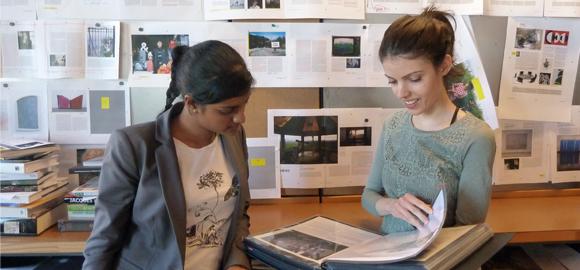At the end of each term, critiques become a key activity at art schools across the country. Though essential to the art education experience, these feedback and evaluation sessions can be stressful for many students. Here’s some tips for dealing with the challenges and opportunities of critique season.
Prepare as much as possible ahead of time
For criticism to be effective, a student must be confident they’ve put their best foot forward. This doesn’t just mean spending time completing work that successfully demonstrates technical and intellectual talent; it means preparing to discuss your work as well. Try your very best not to complete work the day (or night) before; use this time to strategize how you will speak on the work. This includes having some text prepared on the process, inspiration and references present in the work. You should be able to recite this verbally rather than reading it out loud, but do bring some kind of printout: you can fall back on this if you need to. Also, it’s often helpful to bring some questions to pose to your audience to try to generate initial discussion.
Accept that other people have different points of view
In a critique, we often hear feedback we may not agree with—things that might even be incorrect or irrelevant to one’s work—but it is important not to be defensive. Members of your critique group are trying to express themselves too, and this is a process that requires a great degree of fairness and generosity. There are ways to investigate criticism you receive as well: if you don’t understand a classmate’s criticism, ask them to elaborate in a way that will provide you with useful, qualitative feedback.
Sort comments accordingly, and stay attuned to the overall experience
Learn the difference between criticism that is useful and criticism that is not. Don’t lose your cool over criticism that you strongly feel does not apply to you. Try to take in the whole experience and listen, rather than emotionally reacting to one left-field comment to the point where you get distracted from subsequent comments that could be very constructive. If you have prepared ahead of time, you will be better equipped to master this art of sorting.
Be willing to keep learning
Good crits are about more than finding out if your work is good or bad, right or wrong. Take a pen and paper with you and listen carefully to the ideas your work provokes among your classmates. Does it remind someone of an artist you’ve never heard of before? Does it suggest a contemporary or historical event that you were unaware of? Does it do something you didn’t intend it to? Keep track of these references and cues: they are tools to making your work better.
Treasure the rare opportunity a critique presents
Contemporary art is a strange beast, and in a critique, it is ultimately the work, and not what you say about it, that is being judged. There is no way to “win” a crit: it is a learning process on how your work is received by an audience. Don’t be cocky, and treasure the opportunity to engage in a lively and active discourse around your work. And above all, smile! Crits, and art for that matter, are never the end of the world.
Practice self-care, and ask for help when you need it
Feelings of stress are often exacerbated when we are not taking care of our health. For most of us, taking care means alternating activity with rest, eating healthy, avoiding excessive amounts of alcohol and caffeine, staying hydrated, and checking in with people close to us. If you are having many sleepless nights, or other physical and emotional symptoms, it could mean that taking care of yourself also involves seeking professional help. Luckily, many schools have counselling and medical centres set up for just this purpose. Just drop by or make an appointment—both you and your art practice are bound to benefit.

 © Canadian Art Foundation
© Canadian Art Foundation







